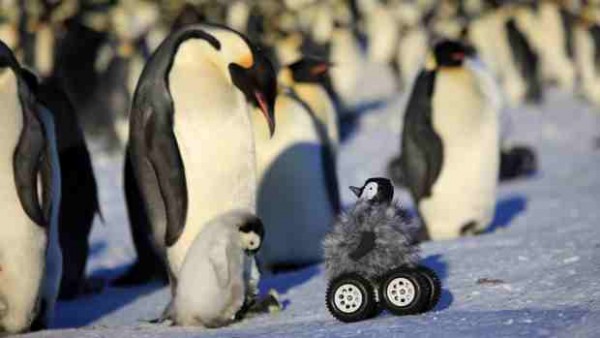Fluffy ‘Robochick” Rover Aids Scientists in Studying Antarctic Penguins
| Kizha T. Trovillas | | Nov 03, 2014 04:33 AM EST |
(Photo : Le Maho et al, Nature Methods) Robot pengin infiiltrates penguin colony
Disguised, remotely-operated rovers used to closely observe penguins in their habitat can help scientists learn the animals' secrets without disrupting their natural behaviors, according to a recent study.
The findings, published Nov. 2 in the journal, Nature Methods, detailed how disguised rovers freely approached skittish Emperor penguins in Adelie Land, Antarctica without causing too much impact on their heart rates and behaviors, allowing the animals to be considered undisturbed.
Like Us on Facebook
Current techniques to reduce animal stress during studies include tagging the animals with Passive Integrated Transponders. These PIT-tags use Radio Frequency Identification (RFID), which is the same technology in swipe cards, to monitor individual animals.
The only downside to the use of PIT-tags is that a reader must get within 60 centimeters of the animals to recognize the tags.
In the new study, researchers led by Dr. Yvon Le Maho from the University of Strasbourg in France looked at minimizing animal stress levels during field studies by using a remotely-operated rover as an antenna to read RFID signals.
Researchers initially sent a plain, four-wheeled rover to infiltrate a colony of incubating penguins. In this setup, the male penguins were almost stationary as they keep the eggs on top of their feet.
The penguins responded with minimal alarm by pecking at the rover. They did, however, allow the rover to get close enough to read their heart monitors. But after the rover stopped moving, the animals' heart rates became more rapid as if a human ha just entered their colony.
Next, the researchers equipped 34 breeding Emperor penguins, which are notoriously shy, with external cardio-frequency meters and data recorders.
They decided to disguise the rover as a penguin chick to continue the study. The first version, which was made of fiberglass, scared the animals. They tried about five versions until they hit the right one.
The rover that was still disguised as a chick penguin but was now covered in gray fur, sported black arms and had a painted face and beak, finally didn't scare away the shy penguins.
The penguins even appeared comfortable with the disguise as chicks huddled against it just like they do with each other.
The study not only shows how disguised rovers can help scientists closely study animals such as Emperor penguins in the Antarctic but also opens up new possibilities to adapt the technology in aquatic and aerial environments.
TagsRovers, Remotely-controlled rovers, Remotely-operated rovers, penguins, Antarctic Penguins, Emperor Penguins, Antarctia, Rover Penguins, Rover as chick penguins
©2015 Chinatopix All rights reserved. Do not reproduce without permission
EDITOR'S PICKS
-

Did the Trump administration just announce plans for a trade war with ‘hostile’ China and Russia?
-

US Senate passes Taiwan travel bill slammed by China
-

As Yan Sihong’s family grieves, here are other Chinese students who went missing abroad. Some have never been found
-

Beijing blasts Western critics who ‘smear China’ with the term sharp power
-

China Envoy Seeks to Defuse Tensions With U.S. as a Trade War Brews
-

Singapore's Deputy PM Provides Bitcoin Vote of Confidence Amid China's Blanket Bans
-

China warns investors over risks in overseas virtual currency trading
-

Chinese government most trustworthy: survey
-

Kashima Antlers On Course For Back-To-Back Titles
MOST POPULAR
LATEST NEWS
Zhou Yongkang: China's Former Security Chief Sentenced to Life in Prison

China's former Chief of the Ministry of Public Security, Zhou Yongkang, has been given a life sentence after he was found guilty of abusing his office, bribery and deliberately ... Full Article
TRENDING STORY

China Pork Prices Expected to Stabilize As The Supplies Recover

Elephone P9000 Smartphone is now on Sale on Amazon India

There's a Big Chance Cliffhangers Won't Still Be Resolved When Grey's Anatomy Season 13 Returns

Supreme Court Ruled on Samsung vs Apple Dispute for Patent Infringement

Microsoft Surface Pro 5 Rumors and Release Date: What is the Latest?










